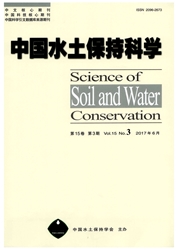

 中文摘要:
中文摘要:
结合塔里木河下游正在实施的生态应急输水工程,以输水年(2000年)前后干流不同测站的径流量以及下游地下水位的变化为基础,分析人为干扰后,塔里木河干流水文情势的变化。结果表明:由于源流区农业灌溉引水剧增,到达干流的水量逐年减少,进入塔里木河干流的水量20世纪50—90年代以0.2亿m^3/年的速度递减,但90年代中期以后有略微增加的趋势;中游英巴扎的径流在输水年前后仍继续减少;下游卡拉站由于人工输水径流量呈增加趋势,从春季到初冬,径流量都大幅度增加,夏季洪峰流量是输水前的2倍,且在时间上有所推后。人工输水后,下游9个生态监测断面的地下水位发生较大变化。纵向上,从大西海子水库向台特马湖方向,地下水位抬升幅度呈逐级递减的趋势;横向上,各个断面的监测井水位呈波段式上升,且愈远离河道波动愈小,5次输水的响应范围达到1200m。下游区生态输水的积极干扰,在一定程度上缓和了源干流上游区人为干扰的负面影响。应急输水工程产生了明显的生态效益。
 英文摘要:
英文摘要:
Combined with the ecological water-transporting project being carried out in the lower reaches of Tarim River, based on the data of runoff and groundwater level, the paper analyzed the change of water regime suffered from man-made disturbance in the main course of Tarim River. The results showed that due to an amount of water diversion for agriculture in the head stream, the the net water input into the main course decreased by 0.2×10^8 m^3/a from 1950 s to 1990 s, but since the mid-1990 s it has exhibited a slight increasing trend. Runoff of Yingbaza still kept decreasing before and after year 2000. However, that of Kala behaved wide-range increase from spring to early winter after water transporting. The peak flow was nearly 2 times that of before and occurred late in time. Meanwhile, the groundwater level of 9 sections changed largely in the lower reaches after water transporting. In longitudinal direction from Daxihaizi to Taitema Lake, the lifting extent showed step-decreasing trend, while in lateral direction, the groundwater level of every well presented band-lifting trend with the times of water transporting increased. The farther away from river way, the less the fluctuation is. The response scope after five times' water transporting bad reached to 1 200 m. To a certain extent, the active disturbance of water transporting in the lower reaches relaxed the negative influence by the disturbance in head stream and upper reaches. The ecological benefit brought by water transporting is positive.
 同期刊论文项目
同期刊论文项目
 同项目期刊论文
同项目期刊论文
 Physiological Responses of Three Contrasting Plant Species to Groundwater Level Changes in an Arid E
Physiological Responses of Three Contrasting Plant Species to Groundwater Level Changes in an Arid E Relationship between soil properties and plant diversity in a desert riparian forest in the lower re
Relationship between soil properties and plant diversity in a desert riparian forest in the lower re Effect of the ecological water conveyance project on environment in the lower Tarim River, Xinjiang,
Effect of the ecological water conveyance project on environment in the lower Tarim River, Xinjiang, Response of groundwater chemistry to water delivery in the lower reaches of Tarim River, Northwest X
Response of groundwater chemistry to water delivery in the lower reaches of Tarim River, Northwest X Daily variation of carbon flux in soils of Populus euphratica forests in the middle and lower reache
Daily variation of carbon flux in soils of Populus euphratica forests in the middle and lower reache Rational groundwater table indicated by the ecophysiological parameters of the vegetation: A case st
Rational groundwater table indicated by the ecophysiological parameters of the vegetation: A case st Analysis on water potential of Populus euphratica oliv and its meaning in the lower reaches of Tarim
Analysis on water potential of Populus euphratica oliv and its meaning in the lower reaches of Tarim 期刊信息
期刊信息
